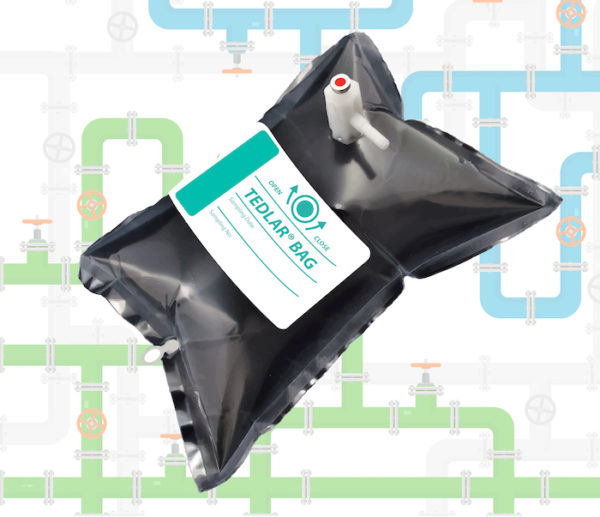The Tedlar® bag has a long history of use in gas sampling applications. Its robustness and ease of use make it a preferred choice of stack testers, plant personnel, and many others. It does, however, have its limitations. Read further to find out more about Tedlar®, what uses Tedlar® bags are best suited to, and when other options may need to be considered.
Polyvinyl fluoride, more commonly known by its trade name Tedlar®, is a thermoplastic fluoropolymer with good chemical resistance and low vapor permeability. It lacks the thermal stability required for injection molding and is thus commonly manufactured and used as a film. Tedlar® bags are typically made by joining two sheets of Tedlar® together by thermally bonding them at the perimeter of the two sheets. They are available with a wide variety of valve options, the “dual poly valve with septum” being the author’s preferred valve for performance and ease of use.
Tedlar® bags are great for sampling a variety of compounds including non-polar hydrocarbons (up to about C8), inert gases (N2, O2, CO, CO2), hydrogen sulfide and organo-sulfur compounds, some halogenated organics, and a few other compounds. Tedlar® bags work best when the sample gas is less than 2% water, though measures can be taken to address water in higher-moisture sources.
At risk of stating the obvious, the sample gas temperature must be well below the melting point of Tedlar® to maintain the integrity of the bag. Per Du Pont, Tedlar® can withstand brief excursions of up to 204⁰C, but sample gas should generally be below about 120⁰C. Also, measures should be taken (i.e. gas regulator, valve/rotameter, etc.) when sampling high pressure sources to ensure that the bag is not rapidly filled to bursting. While Tedlar® is a robust and durable polymer, it is advisable to collect backup/retain samples in case the primary bag samples burst, tear or are otherwise compromised during transport to the laboratory. Also, the use of a “lung box”, or negative pressure sampling container, is advisable when collecting bag samples in order to eliminate the potential for sample loss or contamination from the sampling pump.
Tedlar® bags are best for sources with less than 5% total hydrocarbons. They can be used for higher concentration sources, but care should be taken when sampling and handling sources that may present a safety hazard (i.e. toxic or flammable gases). If there are significant concerns regarding high levels of toxic compounds or other hazards inherent in the sample gas, summa canisters or other appropriate rigid metal containers are a good alternative. The use of rigid containers may require approval from the applicable regulatory body if certain test methods are specified in the test plan.
Tedlar® bags may be used for samples containing hydrogen and helium, but these compounds are able to permeate Tedlar® so these samples should be analyzed as soon as possible after collection to mitigate any losses due to permeation. Again, rigid metal containers may be used to eliminate this problem. Also, composite bags with a Mylar® layer can be used with hydrogen and/or helium to eliminate gas permeation.

If you plan to use Tedlar® bags to sample a source with elevated moisture, greater than about 2%, a chilled knockout impinger should be used to remove moisture from the sample gas upstream of the bag. This is especially important if any target compounds are soluble in water, because condensed moisture in the bag can adversely impact spike recovery for these compounds. The moisture knockout condensate should be analyzed for the target compounds as well, unless the compounds are extremely insoluble in water (i.e. C1-C6 alkanes and alkenes) or an exception is granted by the applicable regulatory agency.
Heavy, polar and/or reactive compounds (i.e. alcohols, ketones, C9+ hydrocarbons) generally do not perform well in Tedlar® bags and Enthalpy can assist with alternative sampling methods for such compounds.
In summary, remember the following when deciding whether or not you should, or shouldn’t, use Tedlar® bags for your gas sampling application:
- Tedlar® bags work best when used with light, non-polar hydrocarbons and inert gases
- Tedlar® bags are somewhat permeable to hydrogen and helium and should be analyzed soon after collection if these compounds are present in significant amounts
- Using a lung box to collect the sample eliminates the potential for pump losses and/or contamination
- Rigid canisters or composite/Mylar® bags are advisable for use with samples containing high amounts of hydrogen and/or helium
- Sources with elevated moisture may require a water knockout/condensate to mitigate condensation in the bag(s)
- Alternative sampling options should be considered for heavy, polar, or reactive compounds


